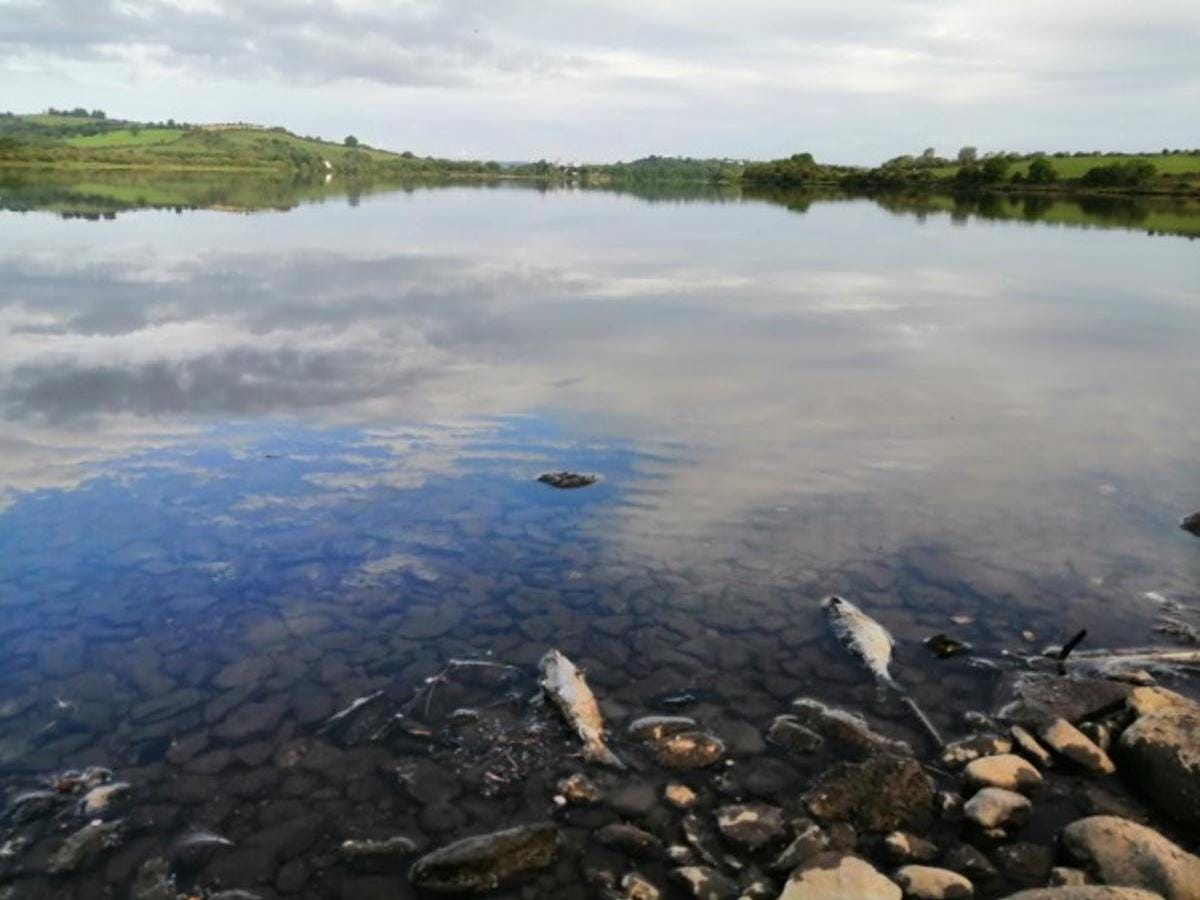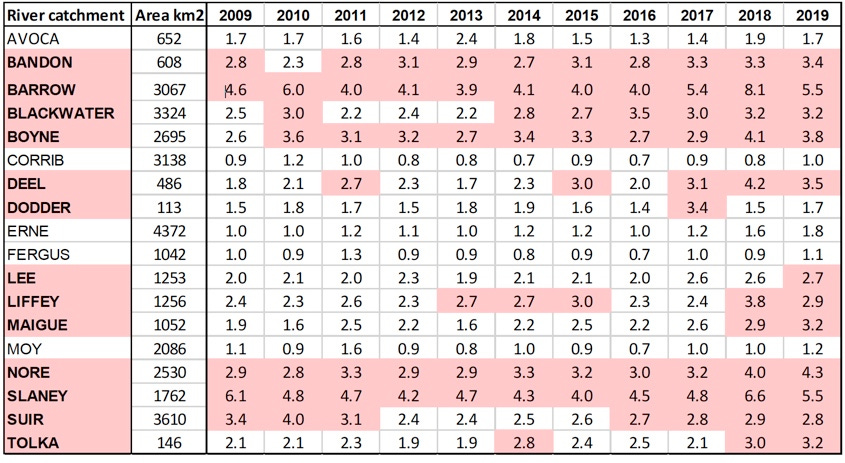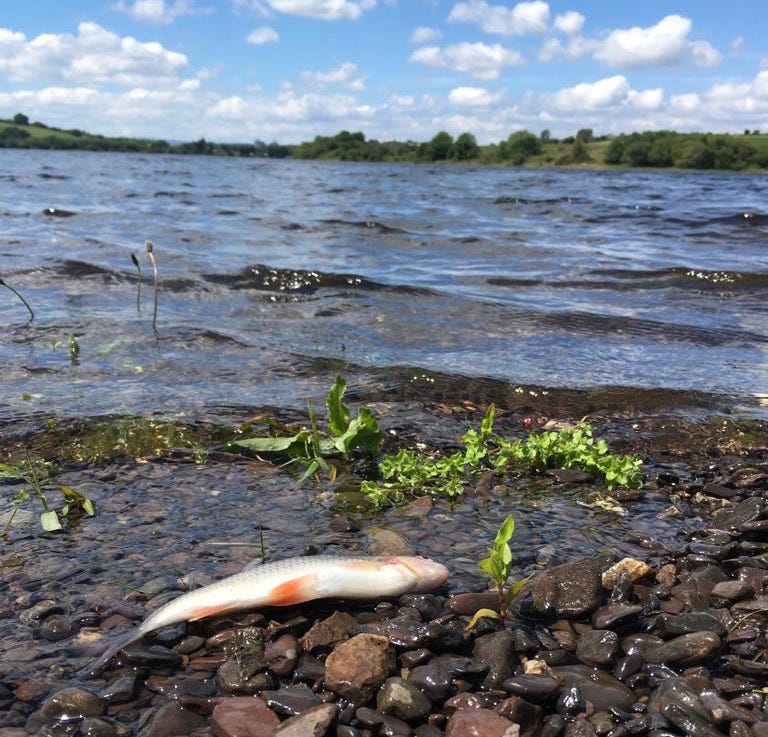Water quality fears at reservoir supplying Cork city
Locals say recent fish deaths and "sludge" in water need further investigation
Dead fish along the foreshore, “dark green sludge” and a grey, slippery line along the water front need urgent investigation, a resident of the Carrigadrohid reservoir lakeside has said.
Horticulturalist Jerry Lehane, who has farmland extending to the edge of the reservoir near Macroom, along with several of his neighbours, first reported what they believe is a fish kill in mid-June to Inland Fisheries Ireland’s (IFI) Macroom office.
“For two weeks before the fish were found, there was a dark sludge in the water of the lake, and the bank was slimy,” Mr Lehane said.
Birds feasting on dead fish
Mr Lehane received a phone-call from his wife asking why there were fish remnants scattered around one of their farm sheds on Sunday June 13. Upon investigating, the couple discovered “a large number” of dead fish along the foreshore. Birds had been carrying carcasses off to their nearby shed roof to feast on them.
Several other neighbours were “up in arms” about the event and also reported it, he said.
The IFI responded quickly to the report, but concluded that the fish deaths were a natural event.
“We became aware of fish mortalities on the Inniscarra and Carrigadrohid reservoirs of the Rudd species on the 14th June,” IFI local division director Seán Long said in an emailed statement.
“Investigations by Inland Fisheries Ireland Senior Fisheries Environmental Officers found dead rudd washed along the shore line in relatively small numbers, ie around 50 in number. The fish are believed to have been post-spawning mortalities, with no external signs of disease: rudd spawn in summer and many subsequently die, a part of their life cycle.”
“Several calls from concerned members of the public were received on this issue including calls to the IFI hotline number, 1890 34 74 24, IFI welcomes such calls as a valuable method of receiving timely information on such issues.”
However, Mr Lehane does not feel Inland Fisheries’ response has been adequate.
Inland Fisheries did not contact the EPA for water quality monitoring information, instead relying on a visual inspection of the water to conclude that there was “no evidence of pollution.”
“Our own observations of the mortalities, the areas in which they were found, plus our inspection of the waterbody while looking for lethargic samples, provided no evidence that pollution was a causative factor,” Mr Long wrote.
More than one species of fish have been found dead, Mr Lehane said. “We were told by the Inland Fisheries representative that the water here was in worse condition 20 years ago than it is now. That’s not true in my experience: I grew up here, and I’ve never seen it so bad. There’s a kind of sludge in the water. All the neighbours agree.”
The Lee catchment exceeds acceptable nitrogen levels for the first time in 2019
This news comes as the EPA publish their Water Quality in 2020: An Indicators Report today, revealing that the River Lee catchment exceeded acceptable nitrogen concentrations for the first time in 2019.
The permitted level is 2.6 milligrammes per litre. The Lee met this upper limit for the first time in 2017, a large jump of .6mg over 2016, and exceeded this concentration for the first time in 2019:
The EPA report highlights the damage nitrogen and other nutrients, frequently from agricultural fertilisers, are causing to water bodies in Ireland, with key catchments of concern in the South and South East.
“Just over half of Ireland’s rivers and lakes are in satisfactory biological quality which means that a large number are unable to sustain healthy ecosystems for fish, insects and plants,” the EPA said in a press release issued on July 14.
Lakes and estuaries are the water bodies with the worst water quality, but the impacts of freshwater systems ultimately also reach the sea. Loads of total nitrogen and total phosphorus to the marine environment from our rivers have increased by 24% (13,559 tonnes) and 31% (338 tonnes) respectively since 2012-2014, the report finds.
Jerry Lehane said he would like investigation of other potential sources of pollution to the Carrigadrohid reservoir, including Macroom town’s Waste Water treatment plant and the Danone Nutricia plant, Europe’s largest infant formula manufacturer, who have their own waste water treatment facilities which discharge to the lake.
Danone Nutricia doubled its manufacturing capacities at the factory in 2012 in response to the abolition of milk quotas in 2015, with a €50 million expansion to the plant.
The factory uses 625 million litres of water from the reservoir each year and have a EPA licence permitting them to discharge treated waste water to the lake.
The factory was fined over €14,000 in 2016 for breaching conditions relating to odours and emissions, and for failing to notify the EPA of an incident involving potential groundwater contamination. The EPA put the company on a watchlist, meaning they could lose their licence if they did not become compliant.
In annual returns made by the company to the EPA, levels of pollutants in waste water discharged to the Carrigadrohid reservoir have been recorded as 100% compliant with permissible levels of nutrients and potential pollutants since 2015.
However, in their latest return, they reported a doubling of hazardous waste from the plant “mainly due to the need to dispose of a larger quantity of sludge from our surface water interceptors in 2020 compared to 2019.”
Drinking water for Cork city
Mr Lehane said he’d like the EPA to come and take water samples to accurately assess the water quality, rather than relying on a visual inspection by IFI. “Without samples taken, we can’t possibly know where we stand,” he said.
He said many locals were in agreement that they were seeing a general decline in water quality and in numbers of fish present over the course of several years and that he believed the issue requires urgent investigation.
In response to my queries, the EPA’s press department sent me a statement:
“The EPA monitors four sites located on the Carrigadrohid Reservoir at a frequency of four times per annum as part of the national Water Framework Directive monitoring programme. Information from these sites can be downloaded from here- Data - Catchments.ie - Catchments.ie.”
Carrigadrohid reservoir is the source of the drinking water for Cork city. The water is treated before entering the public supply.
“I think it’s absolutely nuts that that’s the water people in the city are drinking,” Mr Lehane said. “It would be a mad act, to let the water become polluted and then to try to treat it afterwards.”








Important information for the public
Important information about water quality. The tiny Glen river smells permanently of laundry detergent, household waste is allowed to flow into the river through drainage channels that are tapped into by builders when extensions are added - so I am told by council authorities to locate each drain they say would cost millions... is this true I wonder? It is time to really question what products we allow into our system and get some real leadership on how to tackle this, awareness is vital. thanks for bringing this up, factories at least can be forced to comply.